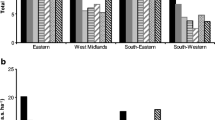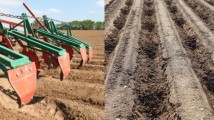Abstract
The transport of agricultural insecticides to water bodies may create risk of exposure to non-target organisms. Similarly, widespread use of furrow-applied and seed-coated insecticides may increase risk of exposure, yet accessible exposure models are not easily adapted for furrow application, and only a few examples of model validation of furrow-applied insecticides exist using actual field data. The goal of the current project was to apply an exposure model, the Pesticide in Water Calculator (PWC), to estimate the concentrations of two in-furrow insecticides applied to maize: the granular pyrethroid, tefluthrin, and the seed-coated neonicotinoid, clothianidin. The concentrations of tefluthrin and clothianidin in surface runoff water, sampled from a field in central Illinois (USA), were compared to the PWC modeled pesticide concentrations in surface runoff. The tefluthrin concentrations were used to optimize the application method in the PWC, and the addition of particulate matter and guttation droplets improved the models prediction of clothianidin concentrations. Next, the tefluthrin and clothianidin concentrations were calculated for a standard farm pond using both the optimized application method and the application methods provided in PWC. Estimated concentrations in a standard farm pond varied by a factor of 100 for tefluthrin and 50 for clothianidin depending on the application method used. The addition of guttation droplets and particulate matter to the model increased the annual clothianidin concentration in a standard farm pond by a factor of 1.5, which suggested that these transport routes should also be considered when assessing neonicotinoid exposure.



Similar content being viewed by others
References
Agatz A, Brown CD (2017) Introducing the 2-DROPS model for two-dimensional simulation of crop roots and pesticide within the soil-root zone. Sci Tot Environ in press, doi: 10.1016/j.scitotenv.2017.02.076
Baker NT, Stone WW (2015) Estimated annual agricultural pesticide use for counties of the conterminous United States, 2008–12. Reston (VA): U.S. Geological Survey Data Series 907, doi:10.3133/ds907
Beven K (1989) Interflow. In: Morel-Seytoux HJ (ed) Unsaturated flow in hydrologic modeling theory and practice. Kluwer, Dordecht: Springer, pp 191–219
Bonmatin J-M, Giorio C, Girolami V, Goulson D, Kreutzweiser DP, Krupke C, Liess M, Long E, Marzaro M, Mitchell EAD, Noome DA, Simon-Delson N, Tapparo A (2015) Environmental fate and exposure; neonicotinoids and fipronil. Environ Sci Pollut Res 22:35–67
Burns LA (2007). User manual for EXPRESS, the “EXAMS-PRZM Exposure Simulation Shell.” Washington, DC: National Exposure Research Laboratory. EPA/600/R-06/095
Chrétien F, Giroux I, Thériault G, Gagnon P, Corriveau J (2017) Surface runoff and subsurface tile drain losses of neonicotinoids and companion herbicides at edge-of-field. Environ Poll in press doi: 10.1016/j.envpol.2017.02.002
Douglas MR, Tooker JF (2015) Large-scale deployment of seed treatments has driven rapid increase in the use of neonicotinoid insecticides and preemptive pest management in U.S. field crops. Environ Sci Technol 49:5088–5097
de Perre C, Murphy TM, Lydy MJ (2015) Fate and effects of clothianidin in fields using conservation practices. Environ Toxicol Chem 34(2):258–265
Girolami V, Marzaro M, Vivan L, Mazzon L, Greatti M, Giorio C, Marton D, Tapparo A (2012) Fatal powdering of bees in flight with particulates of neonicotinoids seed coating and humidity implication. J Econ Entomol 136(1–2):17–26
Girolami V, Mazzon L, Squartini A, Mori N, Marzaro M, Di Bernardo A, Greatti M, Giorio C, Tapparo A (2009) Translocation of neonicotinoid insecticides from coated seeds to seedling guttation drops: a novel way of intoxication for bees. J Econ Entomol 102(5):1808–1815
Goulson D (2013) An overview of the environmental risks posed by neonicotinoid insecticides. J Appl Ecol 50:977–983
HSDB, Hazardous Substances Data Bank (2005) Clothianidin, Hazardous Substances Databank Number: 7281. National Library of Medicine (US), Bethesda (MD), https://toxnet.nlm.nih.gov/newtoxnet/hsdb.htm. Accessed 20 May 2015
HSDB, Hazardous Substances Data Bank (2011) Tefluthrin; Hazardous Substances Databank Number: 7135. National Library of Medicine (US), Bethesda (MD), https://toxnet.nlm.nih.gov/newtoxnet/hsdb. Accessed 20 May 2015
Jeschke P, Nauen R (2008) Neonicotinoids—from zero to hero in insecticide chemistry. Pest Manag Sci 64:1084–1098
Knäbel A, Meyer K, Rapp J, Schulz R (2014) Fungicide field concentrations exceed FOCUS surface water predictions: urgent need of model improvement. Environ Sci Technol 48:455–463
Knäbel A, Stehle S, Schäfer RB, Schulz R (2012) Regulatory FOCUS surface water models fail to predict insecticide concentrations in the field. Environ Sci Technol 46:8397–8404
Krupke CH, Long EY (2015) Intersections between neonicotinoid seed treatments and honey bees. Curr Opin Insect Sci 10:1–6
Limay-Rios V, Forero LG, Xue Y, Smith J, Baute T, Schaafsma A (2016) Neonicotinoid insecticide residues in soil dust and associated parent soil in fields with a history of seed treatment use on crops in Southwestern Ontario. Environ Toxicol Chem 35(2):303–310
Luo Y, Zhang M (2011) Environmental modeling and exposure assessment of sediment-associated pyrethroids in an agricultural watershed. PLoS ONE 6(1):e15794
Miranda GRB, Raetano CG, Silva E, Daam MA, Cerejeira MJ (2011) Environmental fate of neonicotinoids and classification of their potential risks to hypogean, epygean, and surface water ecosystems in Brazil. Hum Ecol Risk Assess 17:981–995
Morrissey CA, Mineau P, Devries JH, Sanchez-Bayo F, Liess M, Cavallaro MC, Liber K (2015) Neonicotinoid contamination of global surface waters and associated risk to aquatic invertebrates: a review. Environ Int 74:291–303
Mueting SA, Strain KE, Lydy MJ (2014) Validation of an extraction method for Cry1Ab protein from soil. Environ Toxicol Chem 33(1):18–25
Munkvold GP, Watrin C, Scheller M, Zeun R, Olaya G (2014) Benefits of chemical seed treatments on crop yield and quality. In: Guillino ML, Munkvold GP (eds) Global perspectives on the health of seeds and plant propagation material, Series: Plant pathology in the 21st century. Springer, vol. 6, Dordrecht, pp 89–103
[NASS] National Agriculture Statistics Service (2011) 2010 Corn, Upland Cotton, and Fall Potatoes. Quick Stats, http://nass.usda.gov/Data_and_Statistics/Pre-Defined_Queries/2010_Corn_Upland_Cotton_Fall_Potatoes/index.asp, USDA-NASS, Washington, DC, USA, accessed 12 May 2015
Nauen R, Elbert A, Mccaffery A, Slater R, Sparks TC (2012) IRAC, insecticide resistance and modes of action classification of insecticides. In: Kramer W, Schirmer U, Jeschke P, Witschel M (eds) Modern crop protection compounds, 2nd edn.. Wiley, Weinheim, pp 753–771
Noshadi M, Forouharfar F, Amin S, Maftoun M (2011) Measuring and simulating 2,4-D residues in silty clay soil profile under two water regimes using a LEACHP model. Iran Agr Res 30:33–45
Paranjape K, Gowariker V, Krishnamuthy VN, Gowariker S (2015) The pesticide encyclopedia. CABI, Oxfordshire, p 726
Pesticide Ecotoxicity Database (2000) Office of Pesticide Programs, Environmental Fate and Effects Division, http://www.pesticideinfo.org. USEPA, Washington, DC, US, accessed 20 May 2015
Reetz JE, Schulz W, Seitz W, Spiteller M, Zühle S, Armbruster W, Wallner K (2016) Uptake of neonicotinoid insecticides by water-foraging honey bees (Hymenoptera: Apidae) through guttation fluid of winter oilseed rape. J Econ Entomol 109(1):31–40
Reichenberger S (2013) Comment “Regulatory FOCUS surface water models fail to predict insecticide concentrations in the field; Environ Sci Technol, 2012 46:8397-8404.”. Environ Sci Technol 47(6):3015–3016
Rothman G, Fry M Meridith Peck C, Lin J, Young D, Khan F, Hetrick J, 2015. Guidance for Using the Volatilization Algorithm in the Pesticide in Water Calculator and Water Exposure Models, Washington, DC: United Stated Environmental Protection Agency, Environmental Fate and Effects Division
Rundlöf M, Andersson GKS, Bommarco R, Fries I, Hederström V, Herbertsson L, Jonsson O, Klatt BK, Pedersen TR, Yourstone J, Smith HG (2015) Seed coating with a neonicotinoid insecticide negatively affects wild bees. Nature 521:77–80
Samson-Robert O, Labrie G, Chagnon M, Fournier V (2014) Neonicotinoid-contaminated puddles of water represent a risk of intoxication for honey bees. PLoS ONE 9(12):e108443
Schaafsma A, Limay-Rios V, Baute T, Smith S, Xue Y (2015) Neonicotinoid insecticide residues in surface water and soil associated with commercial maize (corn) fields in Southwestern Ontario. PLoS One 10(2):e0118139
Schulz R (2004) Field studies on exposure, effects, and risk mitigation of aquatic nonpoint-source insecticide pollution: a review. J Environ Qual 33:419–448
Shamim MT, Hoffmann MD, Melendez J, Ruhman MA (2008) Ecological risk characterization for the synthetic pyrethroids. In: Gan J, Spurlock F, Hendley P, Weston D (ed) Synthetic pyrethroids: occurrence and behavior in aquatic environments: ACS symposium series 991. American Chemical Society, Washington (DC), pp 257–309
Shiu WY, Ma KC, Mackay D, Seiber JN, Wauchop RD (1990) Solubilities of pesticide chemicals in water. Part II: data compilation. Rev Environ Contam Toxicol 116:15–187
Singh S (2013) Guttation: path, principles, and functions. Aust J Bot 61:497–515
Stehle S, Schulz R (2015) Agricultural insecticides threaten surface waters at the global scale. Proc Natl Acad Sci 112(8):5750–5755
Stewart SD, Lorenz GM, Catchot AL, Gore J, Cook D, Skinner J, Mueller TC, Johnson DR, Zawislak J, Barber J (2014) Potential exposure of pollinators to neonicotinoid insecticides from the use of insecticide seed treatments in the mid-southern United States. Environ Sci Technol 48:9762–9769
Tapparo A, Giorio C, Marzaro M, Marton D, Soldà L, Vivan L, Girolami V (2011) Rapid analysis of neonicotinoid insecticides in guttation drops of corn seedlings obtained from coated seeds. J Environ Monitor 13:1564–1568
Tapparo A, Marton D, Giorio C, Zanella A, Soldà L, Marzaro M, Vivan L, Girolami V (2012) Assessment of the environmental exposure of honeybees to particulate matter containing neonicotinoid insecticides coming from corn coated seeds. Environ Sci Technol 46:2592–2599
US EPA (2012) Estimation Programs Interface Suite™ for Microsoft® Windows, v 4.11. United States Environmental Protection Agency, Washington, DC
Whiting SA, Strain KE, Campbell LA, Young BG, Lydy MJ (2014) A multi-year field study to evaluate the environmental fate and agronomic effects of insecticide mixtures. Sci Tot Environ 497-498:534–542
Xue Y, Limay-Rios V, Smith J, Baute T, Forero LG, Schaafsma A (2015) Quantifying neonicotinoid insecticide residues escaping during maize planting with vacuum-planters. Environ Sci Technol 49(21):13003–13011
Young DF (2016a) Pesticide in Water Calculator User Manual for Versions 1.50 and 1.52. Office of Pesticide Programs, United States Environmental Protection Agency, Washington DC
Young DF (2016b) The Variable Volume Water Model Revision A. Office of Pesticide Programs, United States Environmental Protection Agency, Washington, DC, USEPA/OPP 734S16002
Young DF, Fry MM (2016) PRZM5 A Model for Predicting Pesticide in Runoff, Erosion, and Leachate Revision A: User Manual. Washington, DC: Office of Pesticide Programs, United States Environmental Protection Agency USEPA/OPP 734S16001
Zhang X, Goh KS (2015) Evaluation of three models for simulating pesticide runoff from irrigated agricultural fields. J Environ Qual 44:1809–1820
Acknowledgements
The authors would like to thank K. Strain, S. Whiting, J. Thorngren, M. Lydy, S. Stoneski, A. Taylor, and J. Williams for sample collection and processing. Use of a company or product name does not imply approval or recommendation of the product by Southern Illinois University.
Author information
Authors and Affiliations
Corresponding author
Ethics declarations
Conflict of interest
The authors declare that they have no competing interests.
Electronic supplementary material
Rights and permissions
About this article
Cite this article
Huff Hartz, K.E., Edwards, T.M. & Lydy, M.J. Fate and transport of furrow-applied granular tefluthrin and seed-coated clothianidin insecticides: Comparison of field-scale observations and model estimates. Ecotoxicology 26, 876–888 (2017). https://doi.org/10.1007/s10646-017-1818-z
Accepted:
Published:
Issue Date:
DOI: https://doi.org/10.1007/s10646-017-1818-z




